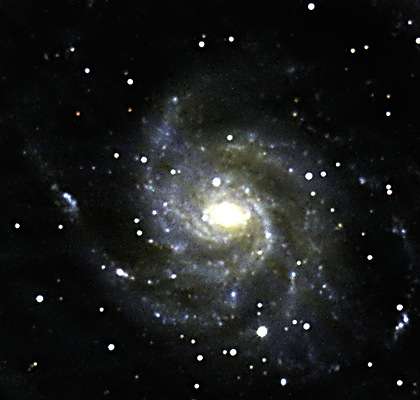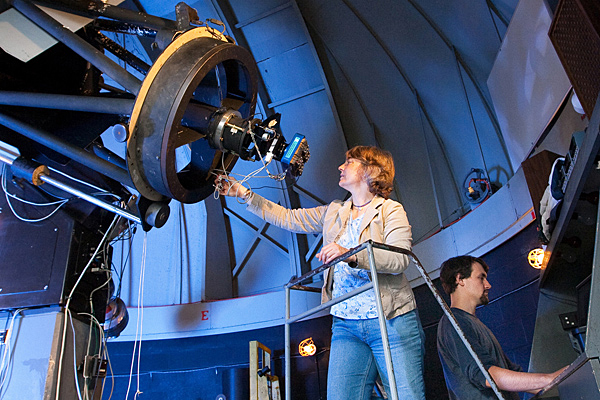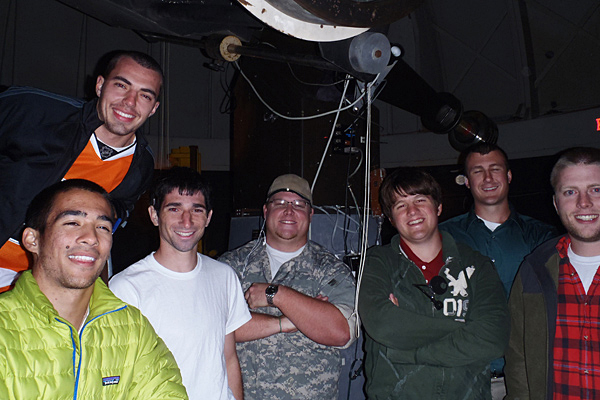


A starburst captured
UD students photograph exploding star in Pinwheel Galaxy
10:57 a.m., Oct. 7, 2011--In the Pinwheel Galaxy some 21 million light years from Earth, a supernova beams brightly, out-shining its cosmic neighbors and causing a stir among starwatchers.
Students in University of Delaware Prof. Judi Provencal’s Observational Astronomy class (PHYS 469) photographed the exploding star last week using the telescope at Mt. Cuba Astronomical Observatory in Greenville, Del., which has a lens spanning 24 inches in diameter.
Research Stories
Chronic wounds
Prof. Heck's legacy
“The supernova, a star that is blowing itself to bits, is the brightest object in the lower center of the image,” Provencal notes. “It is the brightest supernova in the last 20 years and might be visible with binoculars.”
The bursting star, known as PTF 11kly, will eventually fade over the next year or so and then turn into a neutron star or a black hole. The material ejected when it exploded may form new stars.
According to Provencal, PTF 11kly is a “Type 1a” supernova, which means it’s half of a “stellar team” known as a binary star. One of the stars is an “ordinary” star, and the other is a white dwarf, a super-dense star that is the size of the Earth, but has the mass of the sun. Because it doesn’t have nuclear reactions firing away in its core, the white dwarf does not generate any internal energy. Instead, it’s supported against gravity by “electron degeneracy pressure” which occurs when a huge number of electrons are compacted tightly together in a small volume.
The two stars of the binary team orbit very closely together, so close that the “ordinary” star transfers material to the white dwarf. When the white dwarf gains enough material that it reaches a critical mass (about 1.4 times the mass of the sun), electron degeneracy pressure fails and the star will collapse in on itself. This produces a lot of energy, which we see as the supernova, Provencal explains.
“These are the types of supernova that were used to determine that the universe is actually accelerating in its expansion, which has led to the whole field of dark energy,” Provencal says.
The Pinwheel Galaxy inhabited by the PTF 11kly supernova was discovered in 1781 by French astronomer Pierre Mechain, who thought it was a nebula, a gas cloud from which new stars are born. Erwin Hubble later would show that it is indeed a full-fledged galaxy.
Mechain’s fellow astronomer Charles Messier would include it as an item, today still referred to as “Messier 101,” or M101, in his 1781 astronomical catalog.
“Messier’s list was supposed to help with comet hunting since it was a list of fuzzy objects that didn’t move in the sky. Comet hunting was a big deal back then,” notes Provencal.
The Pinwheel Galaxy is a spiral galaxy much like our own Milky Way. It’s called a spiral galaxy for the spiral arms or “spokes” that curve away from a center disk of highly concentrated stars. The stars in these spokes are younger and thus hotter and brighter than the stars at the center.
Although the Pinwheel Galaxy is playing host to the brightest, nearest supernova seen from Earth in years, starwatchers should know that our own Milky Way also sports supernovae from time to time—the most recent one was recorded in 1572, Provencal says.
Article by Tracey Bryant











